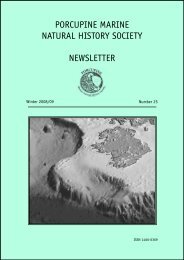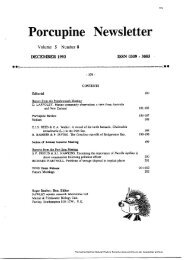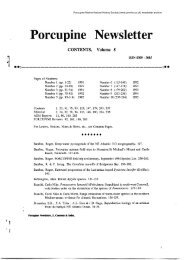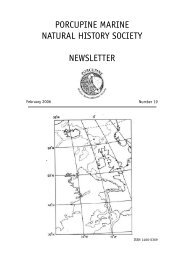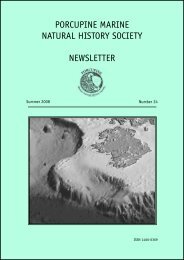Porcupine Newsletter Volume 1, Number 10, August 1980.
Porcupine Newsletter Volume 1, Number 10, August 1980.
Porcupine Newsletter Volume 1, Number 10, August 1980.
You also want an ePaper? Increase the reach of your titles
YUMPU automatically turns print PDFs into web optimized ePapers that Google loves.
+<br />
period to 20-21 days, they will not have experienced a tidal regime in the<br />
laboratory tanks before isolation but would have had a diurnal light regime.<br />
Perhaps more simply it could be a temperature effect.<br />
+<br />
Gray recorded mean brood times of 13.29 - 7.64 days at a mean temperature of<br />
18.2O~ in July and <strong>August</strong> and 16.24 2 9.36 days at a mean temperature of 14.8O~<br />
in September and October. Minimum temperatures are generally acknowledged $0<br />
be of considerable importance in breeding and a daily temperature range of<br />
11-16~ could well have resulted in an increase of the brood period to 20.63 -<br />
0.1805 days. Further carefully controlled temperature studies in a definite<br />
light/dark regime could resolve this.<br />
LARVAL RELEASE<br />
Prior to larval release the parent animal becomes more active, forsaking its<br />
normally secretive behaviour and performing rotational movements with its operculum<br />
and branchial filaments extended. Careful observation reveals that the<br />
larvae within the; brood chamber ars alro active, rotating within their egg<br />
membranes,presumably to rupture them. The larvae emerge singly at first, at<br />
approximately one minute intervals, but within 5-<strong>10</strong> minutes, as the pore widens<br />
and the brood number diminishes, two and three larvae may escape simultaneously.<br />
The adult, unless disturbed, may remain with its branchial crown extended for<br />
the whole period of larval emission (<strong>10</strong>-35 minutes). It is only in the later<br />
stages that the pore can be readily distinguished.<br />
Once free of the pore the larvae remain in close association with the branchial<br />
filaments for at least 75 seconds, the larvae not being readily dislodged even<br />
when the animal withdraws violently into its tube. The larva has a free life<br />
as brief as 1.25 hours if a suitable substratum is available, although this may<br />
be considerably prolonged.<br />
Close observation of the parent reveals that, when the need arises, it can play<br />
an active role in larval release, particularly in those cases where complications<br />
arise with the egg ceabraies. These membranes form a loose mass after<br />
the embryos have freed thomselvas, and are normally voided during or immediately<br />
following the completion of larval release. In some cases, however, the<br />
membrane mac.-;, plus any undeveloped eggs, block the pore and interrupt larval<br />
release. At -cnis time tb2 adult has been observed to lay some of the branchial<br />
pinnules across th2 pore c.nd create a current of water to draw the membrane<br />
mass out from tha opercular brocd chamber; larval emission is then resumed.<br />
THE OPERCULIPi FORE<br />
The opercuiar pore dilates to enable two, and frequently three, larvae to<br />
escape simultaneously. On completion of larval release the pore closes in the<br />
manner of an eliptical iris diaphragm, in most cases being closed to a pinpoint<br />
within 20-25 ninutes. At the same time the brood chamber becomes<br />
deflated basally, where it is not supported by calcification. The normal contour<br />
is regained within one hour and the pore is now represented by a small,<br />
flattened, volcano-like pimpla.<br />
What haopons to the pore between this stage and the entry of a new brood<br />
remains unclear as the active parent of release resumes a secretive life within<br />
its tube, particularly at the tima of transfer.<br />
The closure is a puzzle; why close if the new brood is to enter that way<br />
Available evidence, however, suggests that eggs enter from the outside and<br />
common sense suggests that it is via the pore.<br />
i) In other species eggs are liberated from the anterior abdominal<br />
segments into the ventral ciliated groove (Thorp 1961; Gee and<br />
Wi1lia.n~ 3.962). i see no reason why this should not be the case<br />
in Pileolaria.<br />
-<br />
180<br />
<strong>Porcupine</strong> Marine Natural History Society (www.pmnhs.co.uk) newsletter archive



